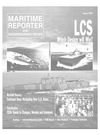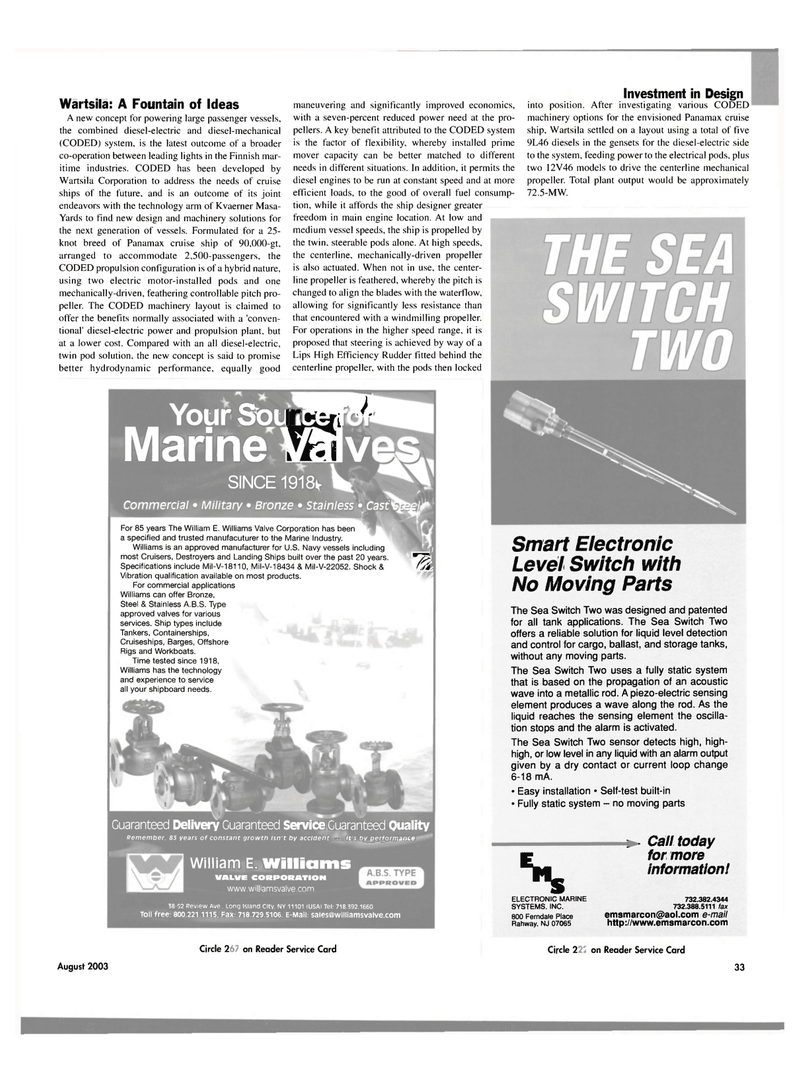
Page 33: of Maritime Reporter Magazine (August 2003)
Read this page in Pdf, Flash or Html5 edition of August 2003 Maritime Reporter Magazine
Wartsila: A Fountain of Ideas
A new concept for powering large passenger vessels, the combined diesel-electric and diesel-mechanical (CODED) system, is the latest outcome of a broader co-operation between leading lights in the Finnish mar- itime industries. CODED has been developed by
Wartsila Corporation to address the needs of cruise ships of the future, and is an outcome of its joint endeavors with the technology arm of Kvaerner Masa-
Yards to find new design and machinery solutions for the next generation of vessels. Formulated for a 25- knot breed of Panamax cruise ship of 90,000-gt, arranged to accommodate 2,500-passengers, the
CODED propulsion configuration is of a hybrid nature, using two electric motor-installed pods and one mechanically-driven, feathering controllable pitch pro- peller. The CODED machinery layout is claimed to offer the benefits normally associated with a 'conven- tional' diesel-electric power and propulsion plant, but at a lower cost. Compared with an all diesel-electric, twin pod solution, the new concept is said to promise better hydrodynamic performance, equally good maneuvering and significantly improved economics, with a seven-percent reduced power need at the pro- pellers. A key benefit attributed to the CODED system is the factor of flexibility, whereby installed prime mover capacity can be better matched to different needs in different situations. In addition, it permits the diesel engines to be run at constant speed and at more efficient loads, to the good of overall fuel consump- tion, while it affords the ship designer greater freedom in main engine location. At low and medium vessel speeds, the ship is propelled by the twin, steerable pods alone. At high speeds, the centerline, mechanically-driven propeller is also actuated. When not in use, the center- line propeller is feathered, whereby the pitch is changed to align the blades with the waterflow, allowing for significantly less resistance than that encountered with a windmilling propeller.
For operations in the higher speed range, it is proposed that steering is achieved by way of a
Lips High Efficiency Rudder fitted behind the centerline propeller, with the pods then locked
Investment in Design into position. After investigating various CODED machinery options for the envisioned Panamax cruise ship, Wartsila settled on a layout using a total of five 9L46 diesels in the gensets for the diesel-electric side to the system, feeding power to the electrical pods, plus two I2V46 models to drive the centerline mechanical propeller. Total plant output would be approximately 72.5-MW.
Your Sour Marine m i v
SINCE 1918*
Commercial • Military • Bronze • Stainless • Cast
For 85 years The William E. Williams Valve Corporation has been a specified and trusted manufacuturer to the Marine Industry.
Williams is an approved manufacturer for U.S. Navy vessels including most Cruisers, Destroyers and Landing Ships built over the past 20 years.
Specifications include Mil-V-18110, Mil-V-18434 & Mil-V-22052. Shock &
Vibration qualification available on most products.
For commercial applications
Williams can offer Bronze,
Steel & Stainless A.B.S. Type approved valves for various services. Ship types include
Tankers, Containerships,
Cruiseships, Barges, Offshore
Rigs and Workboats.
Time tested since 1918,
Williams has the technology and experience to service all your shipboard needs. 73
Guaranteed Delivery Guaranteed Service Guaranteed Quality
Remember, 83 years of constant growth isn't by accident . . . it's by performance
William E. Williams
VALVE CORPORATION www.williamsvalve.com 38-52 Review Ave., Long Island City, NY 11101 (USAl Tel: 718.392.1660
Toll free: 800.221.1115, Fax: 718.729.5106. E-Mail: [email protected]
Smart Electronic
Level Switch with
No Moving Parts
The Sea Switch Two was designed and patented for all tank applications. The Sea Switch Two offers a reliable solution for liquid level detection and control for cargo, ballast, and storage tanks, without any moving parts.
The Sea Switch Two uses a fully static system that is based on the propagation of an acoustic wave into a metallic rod. A piezo-electric sensing element produces a wave along the rod. As the liquid reaches the sensing element the oscilla- tion stops and the alarm is activated.
The Sea Switch Two sensor detects high, high- high, or low level in any liquid with an alarm output given by a dry contact or current loop change 6-18 mA. • Easy installation • Self-test built-in • Fully static system - no moving parts s
ELECTRONIC MARINE
SYSTEMS. INC. 800 Femdale Place
Rahway. NJ 07065 ^ Call today for more information! 732.382.4344 732.388.5111 fax [email protected] e-mail http://www.emsmarcon.com
August 2003
Circle 225 on Reader Service Card Circle 237 on Reader Service Card 33

 32
32

 34
34
